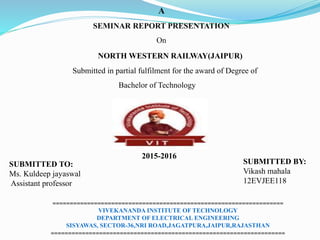Northen Western Railway
- 1. A SEMINAR REPORT PRESENTATION On NORTH WESTERN RAILWAY(JAIPUR) Submitted in partial fulfilment for the award of Degree of Bachelor of Technology SUBMITTED TO: Ms. Kuldeep jayaswal Assistant professor SUBMITTED BY: Vikash mahala 12EVJEE118 =================================================================== VIVEKANANDA INSTITUTE OF TECHNOLOGY DEPARTMENT OF ELECTRICAL ENGINEERING SISYAWAS, SECTOR-36,NRI ROAD,JAGATPURA,JAIPUR,RAJASTHAN ==================================================================== 2015-2016
- 2. Contents: âĒ Introduction Of INDIAN RAILWAY âĒ Locomotives âĒ Railway Train lightning âĒ Railway Air conditioning coaches âĒ Equipments used âĒ Conclusion âĒ References
- 3. INTRODUCTION âĒ Indian Railway has the world's fourth largest railway network . âĒ Indian Railwayâs First train in Indian Railway between Mumbai to Thana on 16th April 1853. âĒ Indian Railway is divided into 17 zones, which are further sub-divided into 67 divisions. âĒ Indian Railway is one of the world's largest commercial or utility employers, with more than 1.6 million employees and there is no strike since last 30 years.
- 4. North Western Railway âĒ It came into existence on 1st oct. 2002. âĒ It is one of the sixteen railway zones in India.
- 5. LOCOMOTIVES: âĒ Steam Locomotive âĒ Diesel Locomotive âĒ Electric Locomotive
- 7. Training Departments 1.Train lighting 2. Air-Conditioning
- 8. Classification of Coaches (Based On Generation) BG COACHES End On Generation Spilt Type Under Slung Roof Mount Package Unit (RMPU) Self Generating AC Coaches Split Type Under Slung RMPU with 25 KVA inverter Non AC Coaches Mid-On Generation
- 9. Train Lighting Systems used in the Train Lighting are: 1. End-On generation 2. Self-Generation 3. Mid-on Generation
- 10. End-On generation âĒ Express Trains Having Heavy Load Use EOG Coaches. âĒ The Power Is Supplied At 3 ÎĶ, 750 V, Which Is Stepped Down In Individual Coach To 3 ÎĶ, 415 V, For Supplying Various Loads Like RMPU, Etc. âĒ The 110 V Ac Supply For Lights And Fans Is Obtained By Further Stepping Down The 415 V Supply. âĒ A 24 V Battery Is Used For Supplying A Few Emergency Lights Provided In The Coach.
- 11. End-On generation Fig: End on generation
- 12. End-On generation âĒ Generator Car âĒ Two generator cars present usually âĒ Consists of two generators in each car âĒ For low value of load only one is in working âĒ Both can be operated simultaneously
- 13. Self-Generating System âĒ The power supply arrangement of SG coach has under slung alternator, which is driven by the running axles of the coach with the belt of the coach. âĒ The voltage of the alternator which varies with the speed of the train is regulated with the help of RRU and converted to 110 v DC and is used for charging the battery.
- 14. Self-Generating System Fig: self generating system
- 15. Mid-onâgeneration âĒ The MOG system was adopted by IR for slow moving passenger trains which have very low generation to non-generation ratio. âĒ These trains had one power car in the middle of the train, which fed power supply to the coaches at either side of power car. âĒ The power car coach had two DA set of 30 KVA each out of which one was used as standby. The power car coach also had one 3 ÎĶ, 30 kVA step down transformer of 415/110 v. The 110 v AC supplied to the coaches through couplers.
- 16. Air Conditioner
- 17. Major Parts of A/C system âĒ Compressor ï Condenser Unit ï Gauge Panel ï Air Duct
- 18. Compressor âĒ Compress the vapour of refrigerant âĒ pressure is about10-15kg/cm2 âĒ raises the temperature of refrigerant vapour âĒ Extracts heat absorbed by refrigerant vapour âĒ Consists of heat exchanger âĒ Fitted with a blower
- 19. Condenser âĒ It is a device or unit used to condense a substance from its gaseous to its liquid state, by cooling it. âĒ Condensers are used in refrigerators, air conditioning, Industrial chemical processes such as distillation, steam power plants.
- 20. Gauge Panel ïIt consists of pressure gauges & pressure cut-outs to protect the compressor against high pressure & low pressure. 1. High pressure cut-out 2. Low pressure cut-out 3. Oil pressure cut-out
- 21. Air Duct âĒ They are used in heating, ventilation & air conditioning to deliver & remove air. âĒ Ducts commonly also deliver ventilation air as part of the supply air. âĒ Three types of air ducts are there:- A) Fresh (inlet) air duct B) Main air duct C) Return air duct
- 22. Conclusion âĒ During my training at north western railway Jaipur , I learnt about basics of generation of electricity in train itself and uses of electricity in railway. âĒ This training helped me out to understand the concept of air conditioning system & train lighting system which enhance my knowledge about the AC & train lighting system. âĒ In this time period I gained a lot of knowledge, experience and ability to work with team.
- 23. REFERENCES 1. Maury Klein, The Power Makers: Steam, Electricity, and the Men Who Invented Modern America Bloomsbury Publishing USA, 2009 ISBN 1- 59691-677-X 2. Climate Tech.Book, Hydropower, Pew Center on Global Climate Change, October 2009 3. British Electricity International (1991). Modern Power Station Practice: incorporating modern power system practice (3rd Edition (12 volume set) ed.). Pergamum. ISBN 0-08-040510-X. 4.Babcock & Wilcox Co. (2005). Steam: Its Generation and Use (41st edition ed.). ISBN 0-9634570-0-4.
- 24. THANK U!
























